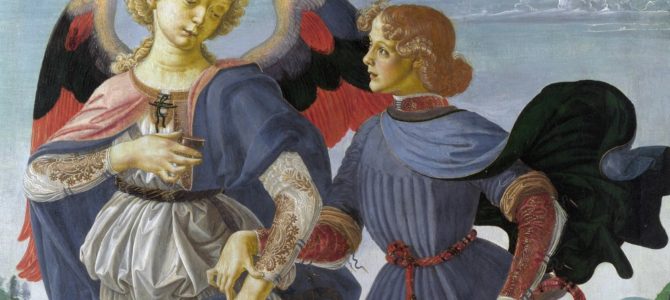
While he isn’t a household name in this country, Andrea del Verrocchio (c. 1435-1488) is one of the most important and influential artists of the Italian Renaissance. An exhibition opening this weekend at the National Gallery of Art in Washington, D.C. will hopefully bring him some long-overdue recognition here in America.
“Verrocchio: Sculptor and Painter of Renaissance Florence” is the first comprehensive exhibition dedicated to this artist ever mounted in the United States. Like the first-ever American retrospective on Tintoretto held at the National Gallery earlier this year, it’s extremely unlikely that such a logistically complex exhibition as this will come to these shores again within our lifetime, so you should absolutely make plans to go see it.
As the exhibition’s curator Andrew Butterfield points out, today we may not realize the enormous significance that Verrocchio had on the development of Western art, both as an innovator and as a teacher. For example, nearly all of the frescoes in the Sistine Chapel were painted either by artists who were once Verrocchio’s students, or who were taught by his former students.
Verrocchio’s work was highly coveted by his patrons, and was produced in a kind of laboratory environment with what Butterfield describes as an “effervescence of creativity”: Sandro Botticelli (c. 1445-1510) was working over in one corner, Leonardo da Vinci (1452-1519) in another, and so on. Amidst all of the hubbub was Verrocchio directing the show, designing goldwork or theatrical costumes, carving tomb monuments and painting altarpieces, or discussing the latest trends in philosophy, science, or music. This was the Renaissance, after all, and masters and students were always experimenting and pushing the envelope in art, as Butterfield puts it, with the goal of “making the art of the impossible possible.”
Verrocchio at the Art Gallery
The National Gallery show is not large, consisting of 51 objects and laid out roughly in the form of a Greek cross. No doubt Alberti and Bramante would approve. To its credit, the museum has placed the objects in such a way that, even at a showing filled with people, it was possible to circulate, stand back to take a better look, or get close to examine some detail, without being distracted either by your neighbor or by a neighboring work of art.
I would have liked to have seen a more vibrant, Florentine palette of red, blue, and gold on the walls, rather than muted grays, slates, and taupes, but the relative blandness of their surroundings does make the color of many of the objects stand out all the more strongly.
One of the “arms” of the cross is set aside for a screening of the exhibition’s accompanying documentary film on Verrocchio, narrated by actress Glenn Close. The other displays roughly one-third of Verrocchio’s surviving drawings, as well as his colossal bronze candlestick from the Rijksmuseum in Amsterdam, and a stunning circa 1465 color study of an old man representing Saint Jerome that comes from the Palazzo Pitti in Florence. It’s a painting that I had never seen or heard of before, but is clearly related to Leonardo’s unfinished “Saint Jerome in the Wilderness” (c. 1480) in the Vatican, as the exhibition text points out.
The Other, Better David
The highlight of the show is unquestionably Verrocchio’s bronze sculpture of “David” (c. 1465), on loan from the Bargello Museum in Florence, which greets you as soon as you enter the exhibition. Of the three most famous Florentine sculptures of David from that era alongside those by Donatello (c. 1440s) and Michelangelo (1501-1504), this has always struck me as the best. It combines the elegance of the rediscovery of the use of the “contrapposto” in Classical sculpture, in which the weight of a figure rests naturally on one leg, and the self-assurance of the up-and-coming Republic of Florence.
I mean, just look at him: David is a rock star. This is no sinuously androgynous figure in a ridiculously oversized helmet, as imagined by Donatello, nor a kitsch attempt at recreating monumental Greco-Roman sculpture, as executed by Michelangelo. The young shepherd and future king of Israel has just strutted onto the world stage with all the swagger of a young Mick Jagger or Robert Plant at a sold-out stadium concert.
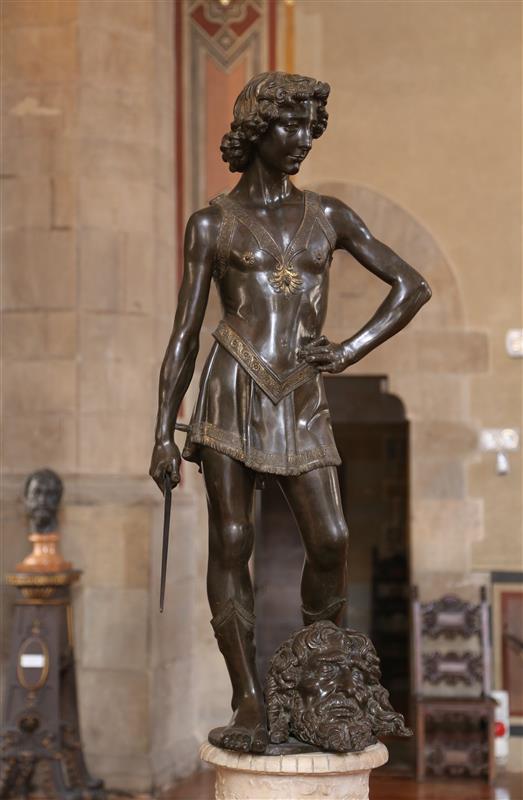
It’s said that the model for the bronze was da Vinci (1452-1519), who at the time was one of Verrocchio’s assistants. But whoever posed for the artist, the Florentines could readily project themselves onto this self-confident young man. In him they could see an idealized representation of their republic, standing up to both neighboring and larger European powers that perennially threatened their prosperity and way of life.
The “David” was commissioned by the Medici family, who were frequent patrons of Verrocchio’s atelier, and portraits of two of them by Verrocchio or his followers appear in the exhibition. Lorenzo de’ Medici (1449-1492), known to history as “Lorenzo the Magnificent,” and his younger brother Giuliano (1453-1478) became the de facto rulers of the republic after the death of their father Piero in 1469. However, a partially botched assassination attempt on the brothers by a rival Florentine family in 1478 resulted in the murder of Giuliano, and the hardening of Lorenzo into an increasingly autocratic figure.
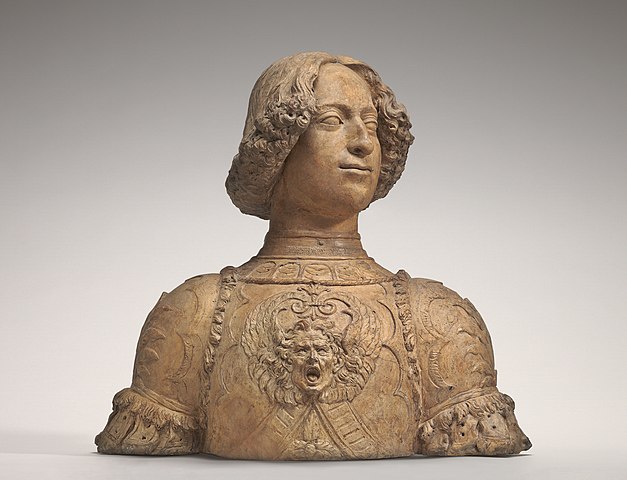
Both busts are in terracotta, a material Verrocchio turned to for both finished works and mock-ups and design work. That of Giuliano, created sometime between 1475 and 1478, is a masterpiece of Medici propaganda, showing the younger brother as the good-looking one, with a full head of thick, wavy hair, confident smile, and dressed in elaborate, fashionable armor.
Lorenzo was certainly not a looker, yet his bust, which is believed to be based on a lost original, is arguably the more interesting of the two. The clothing is more restrained, the face is less idealized, and on close examination, one can even see a bit of five-o’clock-shadow. If Giuliano’s bust could be said to represent the velvet glove of Medici power, Lorenzo’s represents the iron fist contained within it.
The Lady and Her Hands
Perhaps Verrocchio’s most important and influential portrait sculpture has also been lent for the exhibition. It too has a connection to the Medici. “Lady with Flowers,” carved sometime between 1475-1480, is a marble half-length figure of a young woman depicted holding a bouquet to her chest, possibly as an embodiment of a young lady described in love sonnets written by Lorenzo the Magnificent.
Up until this point, sculptors were primarily interested in carving either portrait busts or full-length representations of their subjects. Here, however, Verrocchio has revived an earlier, Classical fashion for depicting a sitter from the waist up, a rediscovery of ancient form which went on to bring back this long-abandoned style of sculpture in Western art.
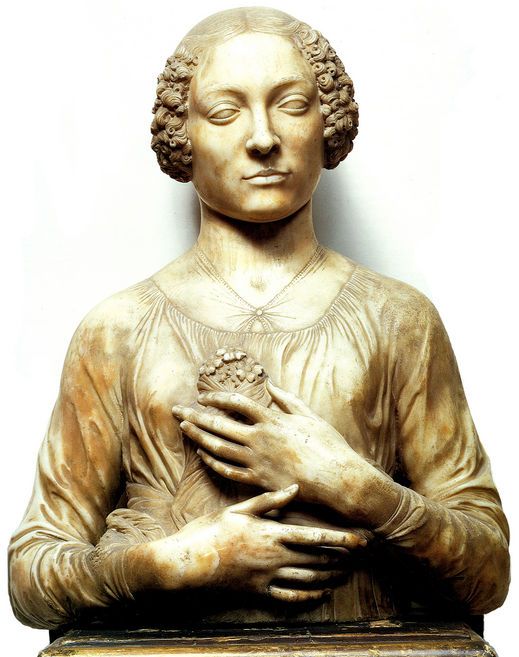
Even in its own day, Verrocchio’s portrait was celebrated for its remarkably beautiful hands, which appear on the cover of the exhibition catalogue. As any artist will tell you, the ability to realistically depict human hands is one of the toughest jobs there is in art.
As it happens, both the subject and her hands may have a significant connection to da Vinci’s “Ginevra de’ Benci,” which was painted around the same time as the creation of Verrocchio’s sculpture, and is displayed nearby in a new, historically accurate frame commissioned for the exhibition. The show explores the fascinating possible connections between the two portraits, and a study drawing now in the Royal Collection at Windsor Castle, leaving this visitor very convinced of their relationship.
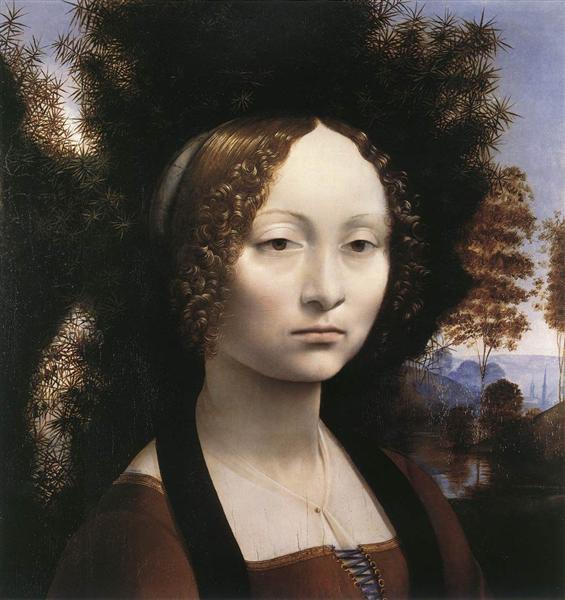
Of course, Verrocchio was both a painter and a sculptor, and while he was perhaps not quite as gifted at the former profession as in the latter, he still managed to develop a successful business creating altarpieces and devotional pictures. He was so successful, in fact, that with a few exceptions historians aren’t even really sure how many pictures he actually worked on.
Like most artists of the period who ran major studios, in some cases he might have little involvement in the execution of a picture, other than in coming up with the design, laying out the composition for his assistants to follow, then adding some finishing touches. Nevertheless, as the exhibition details, Verrocchio’s painting studio is of great significance to art history, both in how he trained his pupils, and in who those pupil were.
Leonardo Da Vinci Pops Up Again
In “Tobias and the Angel,” on loan from the National Gallery in London and painted in around 1470, we see a scene from the Book of Tobit in the Apocrypha, in which the young Tobias sets out on the road with his dog under the guidance of the Archangel Raphael. Taken as a whole, the picture shows how Verrocchio was very much dependent upon ideas that he borrowed from other painters, since it was based on a painting of the same subject by an earlier Florentine artist.
What makes the painting significant is that Verrocchio’s pupil Da Vinci is believed to have painted the very realistic fish hanging from a string in Tobias’ left hand, as well as the more sketchy bichon frise shown running alongside the pair. In addition, like the “David,” the model for the angel is believed to have been Leonardo himself.
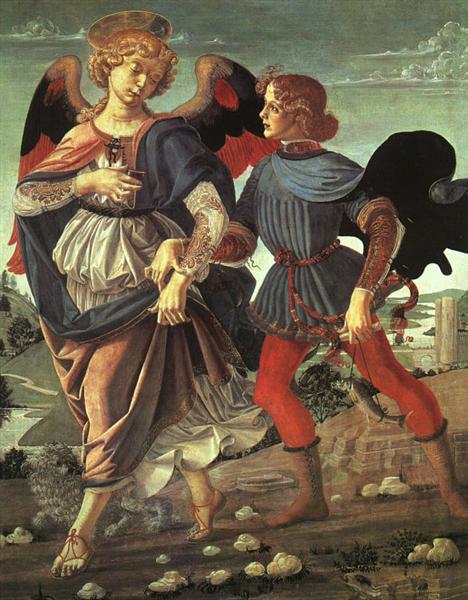
Another religious picture on loan from London is dated to sometime between 1470-1474, and has an even more complicated aspect of what we might call “execution confusion” floating around it. While experts now agree that a decent amount of the “Madonna and Child with Two Angels” was painted by Verrocchio, there’s been a lively scholarly debate for many years as to which of the artist’s famous assistants worked on the painting.
One theory is that parts of the painting are by Leonardo, with other sections by Pietro Perugino (c. 1450-1523), who also went on to found a wildly successful studio, and become the principal teacher of Raphael (1483-1520). Another is that certain areas of the picture are by the slightly weird and arcane Lorenzo di Credi (c. 1459-1537), who became Verrocchio’s principal assistant in the 1480s and inherited the studio upon his master’s death.
To further intrigue visitors about who painted what, or who influenced whom, the exhibition includes a “Madonna and Child” from the same time period as the London painting but by another Florentine artist, Domenico Ghirlandaio (1449-1494), who also spent some time working in Verrocchio’s shop; he later became both a significant fresco painter and the master teacher of Michelangelo (1475-1564).
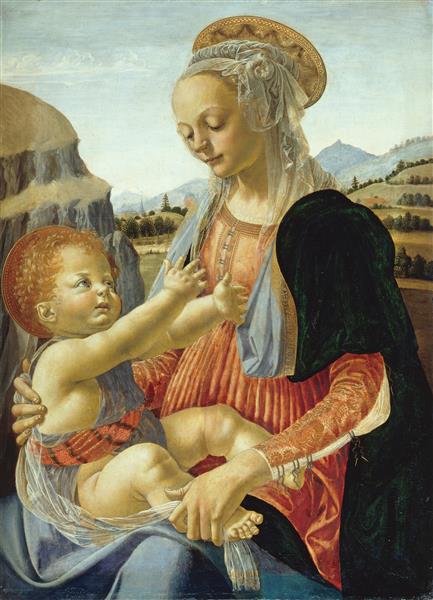
When looking at the two pictures in the show, displayed together in a corner, it’s immediately apparent that either the same model sat for both paintings, or that the painters were working from a formula, even though the real beauty is in the details of fabric, lighting, and the jewel-like, vibrant colors. They’re also so similar in execution that it’s easy to understand why, for many years, the London National Gallery’s Verrocchio painting was believed to be by Ghirlandaio, and the D.C. National Gallery’s Ghirlandaio painting was believed to be Verrocchio.
With a wealth of examples of art by Verrocchio and those he taught and influenced, although the National Gallery’s show isn’t a large retrospective, it’s certainly a substantial one that is well worth your time. Can’t make it to D.C.? In addition to uploading the documentary film created for the show, and talks related to it, the museum will livestream an introduction to the exhibition presented by Butterfield on Sunday, November 3 at 2:00 pm Eastern, on the NGA’s YouTube channel.
“Verrocchio: Sculptor and Painter of Renaissance Florence” opens at the National Gallery of Art in Washington, D.C. on September 15, and runs through January 10.









